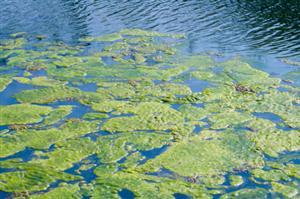| Complexity level: | 1 |
| Project cost ($): | 20 |
| Time required: | 1 day to prepare, 4 days for observation |
| Material availability: | Easily found |
| Safety concerns: | Basic safety requirements, Use gloves and safety goggles/masks when handling the sulphuric acid. |
Hypothesis
Green algae and red algae will be able to survive in acidic water as they are acidophilic plants.
Overview
Acid rain
Acid rain is caused by pollutant gases such as sulfur dioxide and nitrogen, that are emitted as industrial waste and by vehicles, into the atmosphere. These gases combine with moisture in the atmosphere and become sulfuric acid and nitric acid. Rainwater mixes with these acids , and turns acidic. Rainwater that contains these acids will have a lower pH reading and is called acid rain.
Acid rain precipitates at locations far from the source of the pollution. This is because pollutantgasses are carried by the wind for days or weeks and over long distances before they combine with water vapor and return to the ground as rainfall. Normally, rain water has a pH value of around 6.0 but acid rain has pH levels of between 4.0 to 5.5.
Acid rain can cause serious damage to plants and the environment. Plant roots are damaged and plants may experience stunted growth or may even die as a result of acid rain. Most algae are also killed by acid rain. However, some types of algae are acidophilic and are able to survive in acidic waters.
Scientific Terms
Materials
The materials required for this science fair project:
- 15 ml of spirogyra algae
- 15 ml of green algae
- 15 ml of red algae
- Check with an aquarium store, if you do not have easy access to natural habitats
- 9 beakers
- 1 bottle of sulfuric acid
- 1800ml of distilled water
- 1 measuring cylinder
- Several pieces of pH paper
- 1 black marker pen
Procedure
1. For this science fair project, the independent variable is the acidity of the water used for the experiment (pH 5.0, 6.0 and 7.0) and the type of algae – spirogyra, green algae and red algae. The dependent variable is how the algae responds and how well it thrives in the acidic solution. This is determined by observing the algae over a period of time. The constants (control variables) are the amount of water used, the amount of sunlight and the type of algae used.
2. The 9 beakers are separated into 3 groups and labeled as “spirogyra”, “green algae” and “red algae”. The beakers are also labeled as “pH5”,” pH6” or “pH7” and these markings are made beside the names of the algae.
3. Each of the beakers are filled with 200ml of distilled water. The water in the beakers marked “pH 7” is tested with pH paper to verify that it is pH neutral. Sulfuric acid is added to the beakers marked “pH 6” and “pH 5” until the required level of acidity is obtained. The pH levels in each of these beakers is verified using the pH paper. Refer to a pH chart to ascertain the acidity level of the water, given the color that appears on the pH paper.
4. Each type of algae is separated into 3 portions and placed inside (follow the markings on the beakers). The beakers are observed after 5 days to determine if the algae are alive or dead. The observations are recorded in the table given below.
Results
It is observed that red algae is able to survive in the acidic water and is hence acidophilic. Green algae is able to tolerate a small amount of acidity in the water but spirogyra cannot survive in acidic waters at all.
| Water pH | Effect of acid rain on algae | ||
| Spirogyra | Green Algae | Red Algae | |
| 7 | Y | Y | Y |
| 6 | X | Y | Y |
| 5 | X | X | Y |
Y - algae is still alive, X - algae is dead
Conclusion
The hypothesis that green algae and red algae are acidophilic and can survive in acidic water is proven to be correct. However, the green was only able to survive in the pH6 solution, and not in the pH5 solution.
Acid rain is causes a lot of environmental damage around the world. Acid rain is detrimental to many living things. It kills microorganisms living in the soil and stops them from producing nutrients for plants. This causes stunted growth and even results in the death of plants. Lakes lose their fish because of acid rain. People and animals living around the lakes are hence losing a valuable source of food. Buildings, bridges, vehicles and other structures are also affected by acid rain. Acid rain strips structures of their paint and corrodes them. It is therefore important for us to understand the negative effects of acid rain and for us to play our part in helping to keep pollution levels down, in order to prevent its occurrence.
Also consider
What would happen if this science fair project was repeated using other acids such as hydrochloric acid or nitric acid? Would the algae react in the same way?
Have you wondered whether algae are able to survive in basic (alkaline) solutions?
The experiment can be repeated to observe the growth of different types of algae such as the Gonium or Cladophora.
References
Acid rain’s affect on plants and wildlife - http://www.essortment.com/all/acidraineffect_rqmz.htm
The effects of acid rain on pond algae - http://www.ehow.com/list_6467597_effects-acid-rain-pond-algae.html

